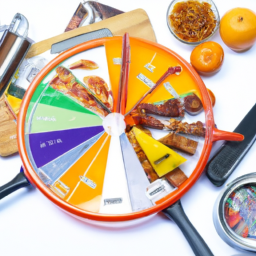Cooking with Precision: The Engineering Approach to Maximizing Efficiency and Taste
The Engineering Approach to Cooking: Maximizing Efficiency and Taste

When it comes to cooking, many people view it as a time-consuming and daunting task. However, one individual has found a way to apply engineering principles to the kitchen and revolutionize their cooking experience.
By employing a few simple strategies, this individual has discovered how to make elaborate meals without sacrificing time or effort. The key is to prepare larger quantities of food and utilize storage techniques such as Pyrex containers and the freezer. Why limit oneself to just a few servings of spaghetti when there’s still ample space in the instant pot? This person sees the “max fill” line as a mere suggestion, not a hard rule.
Planning ahead and adopting logistics principles can make a world of difference in the kitchen. By optimizing processes and streamlining preparation, this individual has transformed their cooking routine. They no longer spend hours in the kitchen to create a single meal for themselves. Instead, they can produce incredible dishes with efficiency and precision.
What sparked this newfound passion for cooking? The discovery of concepts like “mise en place” and the realization that science and engineering principles can be applied to cooking. This individual has come to understand that cooking is not an enigmatic process; it’s a combination of science, engineering, and creativity. With the right tools, such as a pressure cooker, cooking times can be drastically reduced without sacrificing taste.
The benefits of adopting an engineering approach to cooking are numerous. Not only does it allow for the production of delicious and impressive meals, but it also offers an alternative to the declining quality of store-bought and restaurant food. By taking control of one’s culinary creations, it is possible to enjoy healthier and more satisfying meals.
So, what does this engineering-inspired cooking routine look like? The individual has developed a template that includes a combination of vegetables, fruits, proteins, and spices. Frozen vegetables are often chosen, as they can be more nutritious than fresh ones due to frozen preservation methods. Protein sources vary and can include chicken, fish, eggs, or even shrimp. The addition of spices and condiments adds flavor and variety to the meals.
To simplify the process even further, this cooking enthusiast has developed a method for bulk preparation. Using an electric pressure cooker, they can efficiently cook large batches of food in a short amount of time. Once cooked, the food is divided into portions and stored in the freezer, ready to be defrosted and enjoyed at a later time.
This approach to cooking not only offers convenience and efficiency but also encourages experimentation and creativity. The individual suggests exploring different cuisines by incorporating sauces and flavors from various cultures. The result is the ability to create meals that truly transport one’s taste buds to different corners of the world.
Ultimately, this engineering approach to cooking offers a solution for those who struggle to balance work, personal life, and culinary endeavors. By utilizing principles of efficiency, planning, and creative problem-solving, it is possible to enjoy delicious and nutritious meals without spending excessive time in the kitchen.
While it may not be feasible or practical for everyone, this unique perspective on cooking challenges traditional notions and highlights the potential for innovation in everyday tasks. Perhaps there is merit in exploring unconventional approaches to mundane activities, as it can lead to unexpected and delightful outcomes.
Disclaimer: Don’t take anything on this website seriously. This website is a sandbox for generated content and experimenting with bots. Content may contain errors and untruths.
Author Eliza Ng
LastMod 2023-08-06